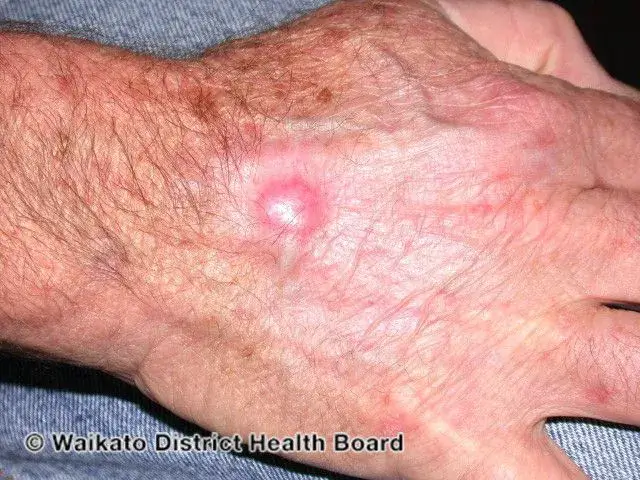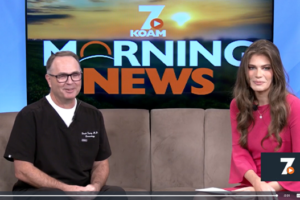Although basal cell carcinoma (BCC) does not readily metastasize, the appropriate removal of BCC can be challenging, especially on the dorsum of the hands due to paucity of extra skin for tissue reconstruction.
Surgical and nonsurgical treatment options can be used to treat BCC, the latter including topical immunomodulators (ie, imiquimod), cryotherapy, radiation, photodynamic therapy, intralesional treatment (ie, 5-fluorouracil), curettage, and electrodessication. However, surgical removal techniques including Mohs surgery and excisional surgery are preferred treatment approach when addressing BCCs, particularly on the hands.1
When addressing skin cancer, Mohs surgery is often favored largely due to its innate tissuing-sparing approach coupled with the guarantee of real-time histologic confirmation of clear margins during the procedure.
“Squamous cell carcinoma [SCC] is the most common skin cancer found on the hands, and although BCCs do occur there, it’s strangely unusual to find them on the hands. BCCs are certainly more common on the face, although the face and hands are similarly exposed to the sun, but SCC appears to be much more prevalent on the hands vs the face, where the ratio is inverted with BCCs,” said Nicholas Golda, MD, FACMS, a Mohs surgeon at US Dermatology Partners in Lee’s Summit, Missouri.
In agreement with the American Academy of Dermatology and the Mohs surgery appropriate use criteria (AUC), Golda said that the hands should be regarded in much the same way as the face as being a high-risk location for cutaneous carcinoma.
“The skin on the hand is scarce and there are not a lot of extra local tissue reservoirs to access to do larger reconstructions. As such, the motivation of getting the tumor treated right the first time with Mohs surgery and in the most conservative manner possible. I would definitely double down on what’s already been shown in the AUC and say that Mohs surgery is probably the most appropriate place to start for the optimal treatment of BCCs and SCCs on the dorsum of the hand,” Golda said.
When performing superficial destruction of a tumor on the hand through electrodessication and curettage or curettage and cryosurgery, once the surgeon breaks through the thickness of the skin and gets below the dermis into the immediate subcutaneous fat, the treatment is considered a failure and an excision must then be performed. According to Golda, this scenario can occur when treating the backs of the hands, where the skin is thin and often fragile.
“I think it is good for clinicians to have an array of treatment options at their disposal to be able to offer their patients the appropriate therapy for their skin cancer. For more complicated cases, I believe clinicians should consider Mohs surgery and should view BCC just as they would SCC on the dorsum of the hand when considering the appropriate surgical procedure in their patient,” Golda said.
Besides Mohs surgery, other removal techniques clinicians can use when treating BCC on the hands include conventional excision as well as superficial destruction techniques such as electrodessication and curettage.
“Once an invasive malignancy is over a centimeter in size, however, Mohs surgery is very likely the best way to go. For superficial malignancies that are under a centimeter in size, I think it would be reasonable to consider other treatment options just to try to expeditiously treat your patient,” Golda said.
Another treatment modality involves superficial radiation therapy but, according to Golda, this approach is not well supported by current National Comprehensive Cancer Network guidelines. The problem with radiation therapy is that one is still making an educated guess in terms of the margins. Moreover, if a younger patient is treated, Golda said, radiation therapy has been shown to increase the risk of BCC formation 2 decades down the line. Radiation therapy cannot typically be repeated in a particular anatomic site, and the effects of radiation on the skin can make future surgical interventions in that area more challenging.
“I am a little bit hesitant about recommending superficial radiation therapy, especially when you are able to achieve such a high cure rate with a surgical cure at a lower cost. It becomes challenging for me to justify doing that therapeutic choice, particularly for something that is a higher risk for carcinoma recurrence such as with morpheaform BCC, infiltrating BCC, or keratinizing BCC. Each of those BCC variants would suggest that Mohs surgery is the most appropriate way to proceed,” Golda said.
Some patients rely on their hands for their livelihood (ie, manual labor, farming) and many who present with these skin cancers on their hands either have an occupation or hobbies that result in sun exposure. As such, it is very important for the physician to try to develop an individualized approach when considering treatment options.
If a more superficial treatment is warranted, such as for a superficial BCC, it is reasonable to opt for curettage and cryotherapy or electrodessication and curettage. However, when performing surgical procedures, particularly involving the hands, Golda always advises being as conservative as possible due to the lack of extra tissue for easy closures.
“Most Mohs surgeons are trained in advanced reconstruction, so if you end up with a bigger defect on the hand, we do have the ability to reach back on the wrist and the forearm to do flap closures to close the back of the hand. We have that skill set at our disposal and in those settings, we are prepared to perform more complicated procedures when necessary. Not to forget, it is easier to justify doing those more involved closures when you know for sure that you’ve gotten all the cancer cells out, and Mohs surgery is the only technique that can provide that assurance,” Golda concluded.
Read Full Article Here








